Text

Frankenstein Friday: It doesn't get much better than this. In the May, 1948 issue of Detective Comics, in a story called "The True Story of Frankenstein," by Bob Kane and Charles Paris, Frankenstein meets Batman and Robin. It's a time-travel plot-device story, and really all very amiable and silly, but still: Batman and Robin and the Frankenstein Monster in the same panel! What 11-year-old boy in 1948 didn't want to see that?
12 notes
·
View notes
Text

Frankenstein Friday: This particularly gruesome-looking Frankenstein is from a cover of student humor magazine *The Sundial* published in 1947. The Sundial is an independent student publication of Ohio State University, and this image illustrated the article, "The Private Life of Frankenstein." I appreciate the attempt to copy the "fuzzy vest" look of the Monster from Universal's Son of Frankenstein, although I wonder why the felt the need to make him even more grotesque than usual for the time. Anyway, his date doesn't seem to mind.
1 note
·
View note
Text

Forty Days of Frankenstein, The Final Frankenstein! And here we are, we made it to Hallowe’en. And I saved the best for last. This really is the most amazing Frankenstein I found this October. And to understand how amazing it is, I have to tell you a story. You probably know that Mary Shelley published the first edition of the novel Frankenstein in the year 1818. You may also know that the novel was first adapted for the stage (loosely) in 1823, a mere five years after its debut, under the title, *Presumption, or The Fate of Frankenstein*. It was very popular. So popular that, three years later in 1826, the play (technically a melodrama) was in turn itself adapted for the French stage under the title, *Le Monstre et le Magicien*. This version made substantial changes to the story, including changing the Monster Maker from a scientist to a sorcerer, and changing his name from Frankenstein (which, at the time, didn’t have the power of name-recognition it has today) to Zametti. This play, also, was wildly popular. So popular, in fact, that it was revived multiple times, including in 1861, which brought it to the attention of a Dutch playwright, who, in turn created a Dutch dramatic ballet based on it in 1865. This ballet, titled *Het monster en de Toovenaar* was also very popular. In 1865 the theater where this production was staged commissioned a series of illustrations depicting the various productions they had put on in recent times, among them *Het monster en de Toovenaar* for use as advertisements which could be hung in cafes. The artist, Charles Rouchussen created this gorgeous depiction of the moment from the play when the Monster threatens to cast a child into the raging river in front of his Maker. No flat head, no electrodes, not even a Pretty Good Sport Coat™—just the pure rage of a Creature at his Creator for having been created.
13 notes
·
View notes
Text

Forty Days of Frankenstein, Final Bits and Pieces: as we’re coming right up on the tail end of this year’s Frankenstein sequence, the prize for weirdest Frankenstein I found this October might just go to tonight’s image. You never do know where the Frankensteins will take you. To understand what we have here, you have to know that DC Comics has a set of “funny animal” superhero characters called *Captain Carrot and His Amazing Zoo-Crew*. Each of the characters is a sort of parody superhero, and in the titular comic the characters have both team adventures and solo stories. In Captain Carrot and His Amazing Zoo-Crew #17 (cover date, July, 1983), the porcine character Pig-Iron (whose super-strong, super-durable body is made of living steel) has a solo adventure titled “The House of Frankenswine” in which he visits the country of West Erminy (the comic specializes in animal puns) and encounters the Monster Frankenswine. This three-panel sequence (art by Rick Hoberg and Carol Lay) of the Monster being brought to life gives a good flavor of the story, penned by the venerable E. Nelson Bridwell. Note the Monster's Karloff/Pierce-influenced design, although in the "fuzzy vest" variant. Temple electrodes, too.
12 notes
·
View notes
Text

Forty Days of Frankenstein, Bits and Pieces: Please take a gander at this piece of fine art created by frequent Frankenstein artist William Stout in 2003. I’ve talked about Mr. Stout before. He’s most commonly known as a paleontological artist, creating drawings and paintings of prehistoric creatures. But he has also created a number of excellent Frankenstein images over the years. This one is to the standard image—Karloff/Pierce-ish, without being a slave to it. This is just a beautifully rendered Monster.
15 notes
·
View notes
Text

Forty Days of Frankenstein, Bits and Pieces: rounding out this final week as we head toward Hallowe'en, I found this image of these great, vintage (from all the way back in 2003, which is 20 years ago, wow!) Hallowe'en window clings. Part of what intrigues me about them is their origin—they weren't made by decoration giant Beistle, or even frequent Hallowe’en contributor Hallmark, but by a small company called JMC Impact, Inc., out of Clara City, MN. I like the way the traditional Karloff/Pierce flathead, greenface, boltneck character has been blended with the look of retro 1950s street toughs—note how in these images the usual Pretty Good Sport Coat™ has been replace by what look to be leather motorcycle jackets. Very nice. These are seriously Hallowe’en Frankensteins, ready with both tricks AND treats!
8 notes
·
View notes
Text
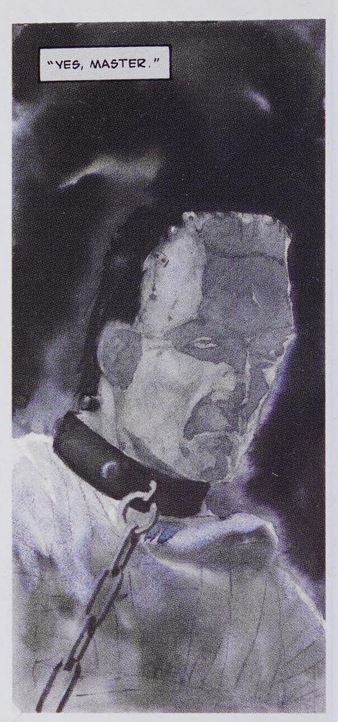
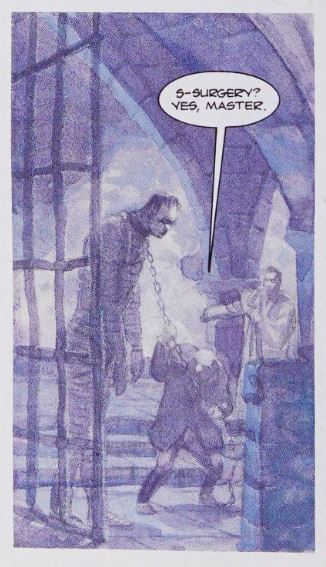
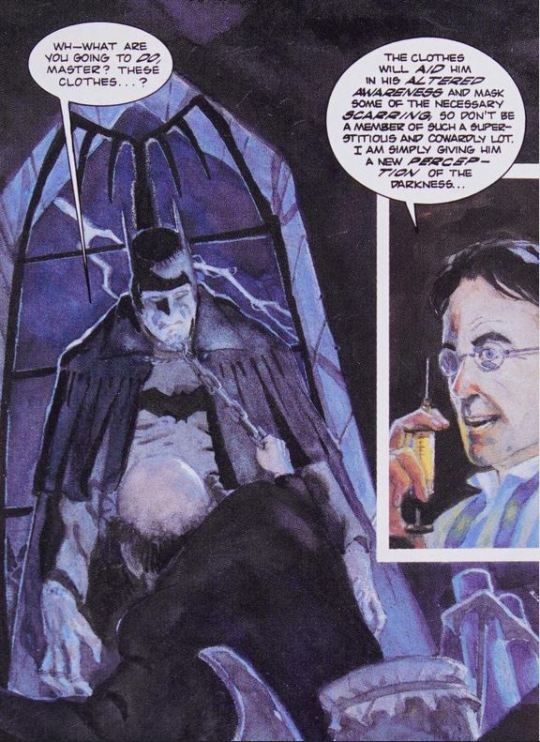
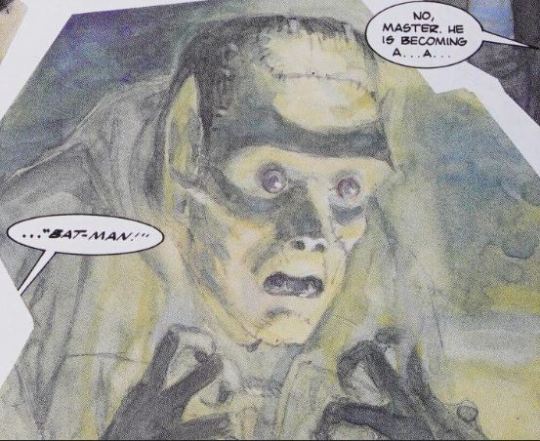

Forty Days of Frankenstein, Bits and Pieces: Here’s something pretty amazing that I just ran across this week. This is a 1995 Elseworlds mashup between the Batman origin story and the 1931 Frankenstein film. It’s pretty great. For those who might not know what an “Elseworlds” is, it’s basically the DC comics version of “What If?” In this case, what if Bruce Wayne was a Victorian era medical student with a hunchback assistant named Alfredo, who uses forbidden science involving the “biological energy” of a bat, to try to bring his murdered father Thomas back to life. The resultant Monster starts out looking like a typical Karloff/Pierce job, but gradually morphs into something altogether more baroque and spectacular. The story is called *Batman: Castle of the Bat*, with beautiful painterly panels by artist Bo Hampton, and it's definitely worth your time.” is, it’s basically the DC comics version of “What If?” In this case, what if Bruce Wayne was a Victorian era medical student with a hunchback assistant named Alfredo, who uses forbidden science involving the “biological energy” of a bat, to try to bring his murdered father Thomas back to life. The resultant Monster starts out looking like a typical Karloff/Pierce job, but gradually morphs into something altogether more baroque and spectacular.
5 notes
·
View notes
Text

Forty Days of Frankenstein, Bits and Pieces: Sometimes there’s a considerable timelapse between when I find an interesting Frankenstein image, and when I’m actually able to learn anything about it. Case in point, this image, which I actually grabbed several years ago, but only just this year was able to put a date and artist to. This is the cover image for a Heinemann (that’s the publisher) ELT reader (which is to say, a reader for someone learning English as a second language), published in 1992. It’s written at approximately a second-grade reading level, which I love, because, after all, just because a person is new at English doesn’t mean he or she shouldn’t get to enjoy Frankenstein. The art is by prolific Hungarian illustrator Victor G. Ambrus. The nods to the Karloff/Pierce makeup are subtle here—a hint of flatness to the head, some seams that might simply be wrinkles but might be stitches, the barest green tint, most visible around the eyes. This Monster is disturbing without being disgusting. You might sit beside him on a bus and barely notice him, but if you met him in a dark street after midnight, you might need a therapist.
7 notes
·
View notes
Text

Forty Days of Frankenstein, Bits and Pieces: Here’s a bonus Frankenstein I ran across recently, from 1959 Brazil. Brazilian comic books have always been an interesting source of Frankensteinery for me, but this one is the earliest example I’ve found so far of Frankenstein in a Brazilian comic, and it does not disappoint! I wish I had more information about this book. I suspect it’s a sort of “Classics Illustrated” retelling of the Mary Shelley novel. But I have nothing on who created this striking cover image. There’s so much to enjoy about this starting with the creepy font. I wish that font were available on my computer; I would use it for all kinds of things! It’s interesting that the Monster is definitely echoing the 1931 Karloff/Pierce film makeup but very toned down. There’s only a suggestion of the flat head, and just a little light stitching near the right eye. The main draw, for me, is the Monster’s unusual asymmetrical single temple electrode. You don’t see that often. All in all, a very fine Frankenstein.
16 notes
·
View notes
Text
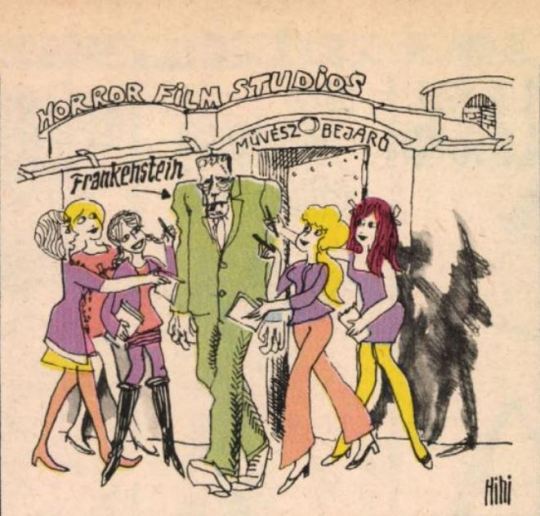
Forty Days of Frankenstein, Bits and Pieces: So, after I get to day Forty, I like to fill out the remaining days till Hallowe’en with Frankenstein images I found this year, but too late to squeeze into the sequence. And this one, well, it may not look like much, but to me it’s a veritable White Whale. Up until this year, I had been completely unable to find a Frankenstein image produced in the year 1956. There wasn’t a film, a comic book, a boardgame, a book cover, a TV teleplay, an advertisement, nothing. And I’ve been seriously following the Frankensteins for over a decade. This year, though, I finally found this. It’s a one panel cartoon, taken from a 1956 issue of a satirical newspaper called Lúdas Matyi (literally “Mattie the Goose-Boy,” a Hungarian folk hero whose story is told in an epic poem). The newspaper, a product of Communist Hungary, pokes fun at decadent Western capitalist values, as in this cartoon, in which beautiful women fawn over the unattractive Frankenstein Monster, because he’s a famous movie star. Note, the term behind the Monster is “művészbejáró,” which, as far as I can determine means “actors’ entrance,” in context. I love the fact that, in this reality, as is often the case in cartoons of the era, it’s the actual Monster himself, rather than some actor playing the Monster, who’s the Hollywood star. Note, also, that the Monster works at “Horror Film Studios.” Alas, no such studio exists. Also worth noting, the Monster’s usual Pretty Good Sport Coat™ is, in this depiction, a Pretty Good Suit. I cannot tell you how excited I was to find this cartoon—as far as I have discovered so far, the only piece of Frankenstein media produced in all of 1956.
7 notes
·
View notes
Text
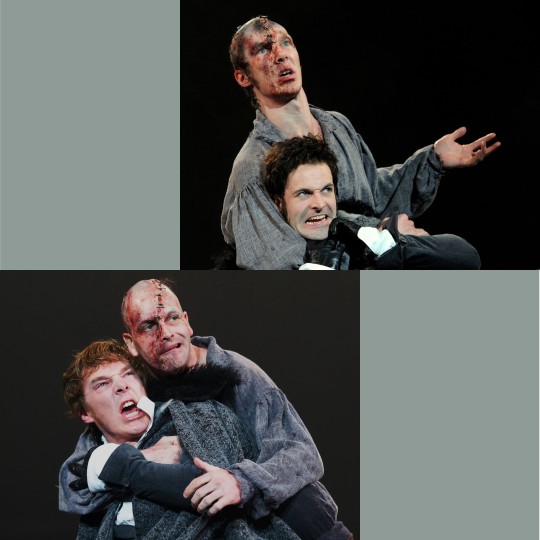
Forty Days of Frankenstein, Day Forty: And here we are, day forty. Don’t despair, though. Between tomorrow and Hallowe’en, I’ll be sharing some late-breaking Frankensteins I found just this year (in my neverending Frankenquest) that were too late to make the first round. Tonight, though, I bring you something extra special. If you care at all about Frankenstein, you should see this if you ever get a chance. If you only see one modern Frankenstein interpretation, see this one (hard to believe it’s already 12 years old). Back in 2011, director Danny Boyle brought Nick Dear’s script for Frankenstein to the Royal National Theatre stage in London. Starring in it were Benedict Cumberbatch and Jonny Lee Miller—but with a twist. In a mind-bending tour-de-force, the two actors alternated between playing Victor Frankenstein and the Creature! From time to time this gets a re-release to cinemas, even though it was originally live on stage. Frustratingly, so far, none of the powers-that-be will release it to home video, so just keep an eye out!
24 notes
·
View notes
Text

Forty Days of Frankenstein, Day Thirty-Nine: More fan art, this time a very excellent 2011 redesign to the Monster by artist Rogier B. Note the blend of standard elements (green skin; flat, cylindrical head), along with innovations that, while not found in the original Karloff/Pierce makeup, are often added by artists (temple electrodes instead of neck ones; two different color eyes; pointy, fang-like teeth; forehead stitches instead of clamps). Additionally, though, this artist has found a way to use the “tall head” that’s usually only found in cartoons and parodies, and make it look cool by adding an exceptionally buff physique and awesome, lightning-like electrical effects. I would watch the adventures of this Frankenstein, and you know he’d be having some:
0 notes
Text

Forty Days of Frankenstein, Day Thirty-Eight: I’m not that much of a gamer, but I am intrigued by the sheer volume of Frankenstein content in area of games: computer games, arcade games, phone games, role playing games, and, as in today’s Frankenstein, tabletop games. This is box art for a 2011 game called *Frankendie* (the “die” part is pronounced as the singular of “dice” because that’s what it’s played with). I haven’t played the game, but it looks pretty fun. Someone, if you are a gamer, please check it out and let me know. Anyhow, the art is by an artist named Darren Calvert, and it’s designed to emphasize the “cobbled together out of spare parts” nature of the Monster, because in the course of the game, that’s what you’re doing: building a Monster out of parts. Note how, despite manifestly originating from the standard Karloff/Pierce design, the artist has definitely gone his own way. There’s the unusual “cubehead” design (rather than the more standard flat cylinder), that in this case also includes a literal “square chin.” There’s the temple electrodes (instead of standard neck ones), which, in this case are actual protruding studs with nuts screwed onto them. And of course, the asymmetry of the pants, the shoes, and the unevenly torn Pretty Good Sport Coat™. Altogether a very good design that leans traditional, but breaks out in all sorts of creative ways.
3 notes
·
View notes
Text
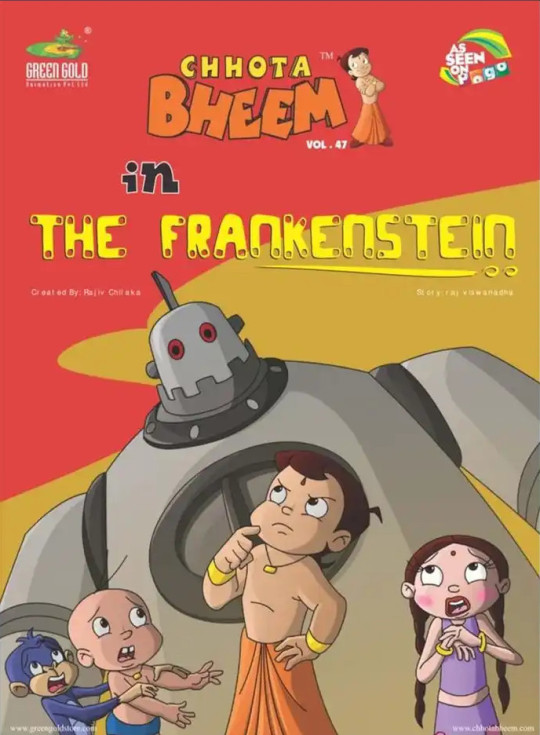
Forty Days of Frankenstein, Day Thirty-Seven: Well, how about a Frankenstein from India? One of the interesting things about following the Frankensteins is the way it opens me up to a wider world of media. In India, since 2008, one of the most popular animated cartoon characters is a little boy named Chhota Bheem (yes, that’s two h’s in a row, there). His adventures are broadcast in the four major languages of India. He doesn’t have any superpowers of anything, but he comes equipped with a lot of moxie and a helpful friend-group. He also has a spin-off comic series. And in this book, volume no. 47, published in 2011, Chhota Bheem encounters a robotic Frankenstein monster created by a local mad scientist. When “the Frankenstein” threatens his village, Bheem must figure out a way to stop him.
0 notes
Text
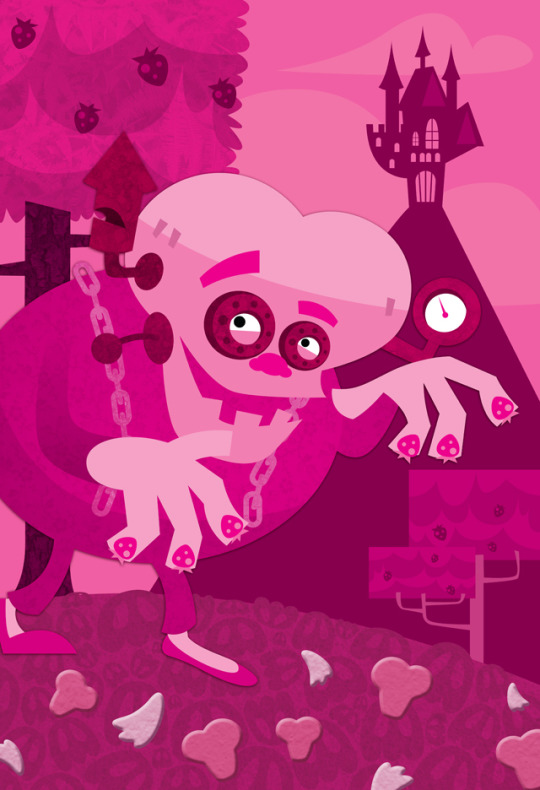
Forty Days of Frankenstein, Day Thirty-Six: One of the things that might surprise you if you don’t chase the Frankensteins the way I do is the sheer quantity of high-quality fan art that’s out there. By “fan art” I mean art done simply because the person is a fan of the thing, not for any particular commercial, money-making application. We’re not talking about fine art prints, or book cover art, or posters or box art for a product. It’s just art “because.” And it’s not just actual Frankensteins, either. It’s your Brides of Frankenstein, and your Edward Scissorhands, and your Frankenweenies. And Franken Berry. A truly baffling amount of high-quality Franken Berry fan art. Like this 2011 piece, from artist Jeremy R. Scott. Enjoy its majesty.
6 notes
·
View notes
Text

Forty Days of Frankenstein, Day Thirty-Five: So, I have a theory of sorts—call it Eernisse’s conjecture—which I’ve seen evidence of time and time again. Given a major pop-culture character with a sufficiently long story run, the character in question will eventually, at some point, encounter the Frankenstein monster. (An inverse corollary is that if a major pop-culture character has not encountered the Frankenstein monster, it is merely because the character’s story run is currently insufficiently long.) A list of pop-culture character who have encountered the Monster in some form or fashion includes: Dracula, Mighty Mouse, Batman, Bugs Bunny, Popeye, Woody Woodpecker, Mr. Magoo, Ernie and Bert, Sherlock Holmes, Santa Claus—the list goes on and on. And in 2011, cover dated November, Mike Mignola’s excellent creation Hellboy met the monster, in an original graphic novel, *Hellboy: House of the Living Dead*. It’s a loving valentine to the 1944 Universal monster mash *House of Frankenstein*, mixed with Mexican luchador monster movies. Hellboy and the Monster end up drinking tequila in a bar together, which is exactly what you want. The Monster’s design is very over-the-top, with a truly silly number and placement of electrodes. It works, though.
15 notes
·
View notes
Text

Forty Days of Frankenstein, Day Thirty-Four: So, I’ve posted before about Kaibutsu Kun, the Japanese manga and anime character from 1965. His name means, “Little Monster,” and in the course of his stories, which are about how he’s the Prince of Monster Land, he become friends with the three greatest monsters of all, Dracula, the Wolf Man, and Frankenstein. He has lots of adventures, and in 1968 he gets his first anime. Subsequent animes would occur throughout subsequent decades. And in 2011, the character of Kaibutsu Kun finally got his live-action debut. And his friend the Frankenstein monster was on-hand, being played by actor and wrestler Choi Hong-man, a seven-foot tall Korean. Is this live action film great? No. Does it breathe new life into characters from the mid-60s? Also no. But is it interesting for what it is? Sure.
6 notes
·
View notes